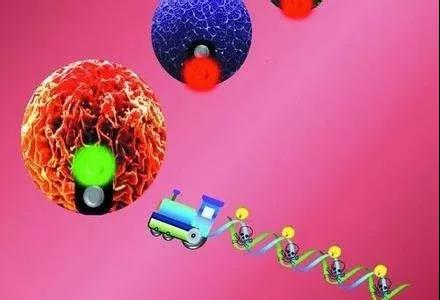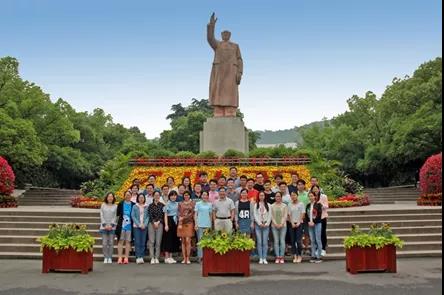The selection process of Top 10 ZJU Academic Advances 2019 was officially launched on January 16, 2020. A panel of judges, consisting of distinguished members of the ZJU Academic Committee and specially invited experts, evaluated candidate projects and singled out 10 projects as the best 10 academic advances on May 11. The project Development of Active Infiltration High Efficiency Anti-tumor Nano Drugs headed by Prof. SHEN Youqing from the College of Chemical and Biological Engineering(ZJU CBE) was successfully selected as one of them.
Abstract:Anti-cancer nanomedicines have wide and urgent clinical needs. But limited penetration and poor spatial distribution of conventional nanomedicines throughout solid tumors represent significant barriers to their anticancer efficacy. Shen’s lab first demonstrated an active penetration mechanism that enable nanomedicines to actively extravasate into and infiltrate in solid tumors, which led to radically increased anticancer activity.

Shen Youqing, Qiushi distinguished professor and director of Bio-Nano Engineering Center of ZJU, received Bachelor and Doctor of Science from Zhejiang University respectively in 1991 and 1995, and won the first National award for doctoral thesis; In 2002, he received a doctor's degree in engineering from McMaster University, Canada, and since 2002, he has been assistant professor of Wyoming at the University of Wyoming in the United States; In 2007, he was exceptionally promoted to associate professor of tenure; In 2008, he was invited to return China to serve as Qiushi scholar professor and director of the Bio-Nano Engineering Center of Zhejiang University, and was awarded by The National Science Fund for Distinguished Young Scholars in the same year. He published more than 280 SCI papers in internationally renowned academic journals such as Nature Nanotechnology, Nature Biomedical Engineering, J. Am. Chem. Soc., Angew. Chem. Int. Ed. And Adv. Mater., H-factor 60, and published RSC 1 book each with Wiley, obtained more than 10 Sino-US patents, and was reported three times by the US Chemical & Engineering News.

Stimulate the initiative and express the nano drug to each tumor cell
Anti-tumor nanomedicine, like a package that directly reaches the tumor, can specifically deliver the drug to the lesion. However, the currently widely used nano drugs only deliver drugs to tumors, rather than to each tumor cell, and therefore fail to significantly improve the efficacy of the original drug. This is like a courier delivering a package to a community communication room, but failing to reach the user. Based on this, the team of Professor Shen Youqing from the ZJU CBE proposed a new mechanism for the active penetration of nanomedicine in tumor tissues, and verified that this method can significantly improve the anti-tumor efficacy with various animal models. Related results were published in Nature and Nanotechnology in July 2019.
Bypassing the dense forest, relays are carried out in tumor cells: the nanomedicine for treating cancer is obtained by loading small molecule antitumor drugs into nanometer-sized carriers. Its diameter is 10-100 nanometers, which is dozens of times that of small molecule drugs, and it can be called a veritable elephant-grade drug. It is understood that compared with small molecule drugs, the advantage of nano drugs is that they can avoid kidney filtration after being injected into the blood and stay in the blood for a longer time, which can accumulate more in tumors. Confined to its huge volume, its own diffusion capacity is very weak. The tumor lacks a capillary network, has a very dense extracellular matrix and a very high cell density. The diffusion of nanomedicine in tumor tissue is as difficult as an elephant in the primordial jungle where the branches spread. As a result, even if the nanomedicine can accumulate in the tumor, it cannot deliver the drug directly to every cell. In response to this problem, scholars at home and abroad have used methods such as reducing the density of tumor tissues and reducing the size of nano drugs to reduce the resistance of nano drugs to the tumor. It leads to problems such as poor passive penetration ability in tumors relying on self-diffusion. Is it possible to use the high tumor cell density in the tumor to allow nanomedicine to directly pass through the tumor cells and bypass the dense vine barriers of the tumor extracellular matrix? Principle, designed a method for tumor cells to actively deliver drugs. The surface of the tumor cells is negatively charged. As long as the nanomedicine is positively charged, it can be easily adsorbed on the cell surface and be 'endocytosed. Professor Shen's team designed the experiment to allow the tumor cells to engulf the nanomedicine, and then spit out a part on the other side, and so on and back, passing the nano drug out of the tumor capillaries.
Between throughput, the drug achieves efficient penetration: The cells will only drain some drugs when they are full enough. Nano drugs originally appear to be electrically neutral or electronegative in the blood, and need to be in the tumor blood vessels or tumor cells When it is nearby, it will quickly become positively charged, so that the cells can swallow a sufficient amount of nano drugs. How to make the medicine turn rapidly in a specific environment has become the key to this relay race. The high expression of γ-glutamyl transpeptidase on the endothelial cells of tumor blood vessels and tumor cells near the blood vessels has become our tool to transform the drugs in the blood into positive electrical charges. Professor Shen Youqing's team The characteristics of high expression nearby, designed and synthesized with its responsive polymer, can make the drug quickly appear positive after reaching the tumor, and then complete the trans-cellular transport. After the nano-medicine is swallowed in the cell, how can it be generously spit out? This ejection link is a function of the cell itself. The Golgi body in the cell is like a courier transfer station, and the material transferred to the Golgi body will be packaged and sent out. By controlling the structure of the nanomedicine, it is swallowed and enters the Golgi apparatus instead of other organelles. In this study, we also used a variety of animal models to investigate the efficacy of the new structure of nanomedicine. The results show that the nanomedicine injected into the tail vein can cure small tumors with a volume of 100 cubic millimeters, while allowing 500 cubic millimeters (equivalent to In the human body, 15 cubic millimeters) of large tumors rapidly shrank and became smaller, and there was no obvious rebound after stopping the drug for half a month. The tumor inhibition rate was as high as 98%. Pancreatic cancer, known as the king of cancer, also has the ability to significantly inhibit its tumor growth and prolong survival. This strategy of turning passive penetration into an active strategy allows nanomedicine to avoid the natural biological barrier formed by the dense microenvironment of tumor tissues, overcoming the natural defect of low diffusion capacity caused by the large size of nanomedicine, and is expected to solve the penetration of nanomedicine in tumor tissue The difficult problem opens up new ideas for the design of the next stage of nanomedicine.


